七年级上册英语语法大全(整理版)
- 格式:doc
- 大小:79.50 KB
- 文档页数:17
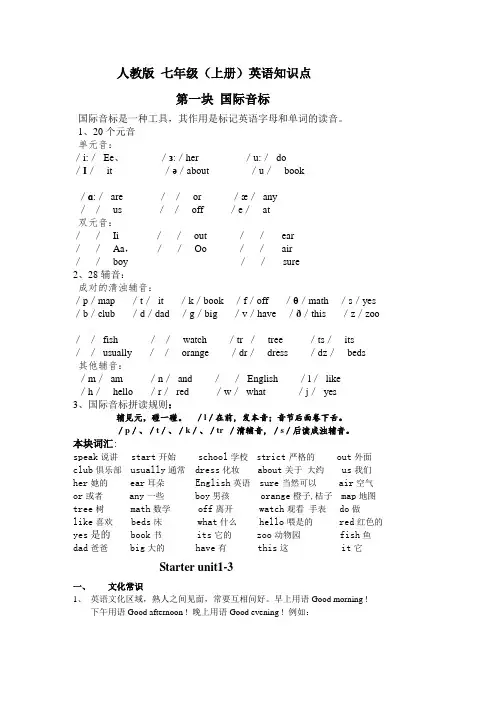
人教版七年级(上册)英语知识点第一块国际音标国际音标是一种工具,其作用是标记英语字母和单词的读音。
1、20个元音单元音:/i:/Ee、/з:/her /u:/do/I/it /ә/about /u/book/ɑ:/are //or /æ/any//us //off /e/at双元音://Ii //out //ear//Aa,//Oo //air//boy //sure2、28辅音:成对的清浊辅音:/p/map /t/it /k/book /f/off /θ/math /s/yes /b/club /d/dad /g/big /v/have /ð/this /z/zoo//fish //watch /tr/tree /ts/its//usually //orange /dr/dress /dz/beds其他辅音:/m/am /n/and //English /l/like/h/hello /r/red /w/what /j/yes3、国际音标拼读规则:辅见元,碰一碰。
/l/在前,发本音;音节后面卷下舌。
/p/、/t/、/k/、/tr /清辅音,/s/后读成浊辅音。
本块词汇:speak说讲start开始school学校 s trict严格的out外面club俱乐部usually通常 dress化妆about关于大约us我们her她的ear耳朵English英语sure当然可以air空气or或者any一些boy男孩orange橙子,桔子map地图tree树math数学 off离开watch观看手表do做like喜欢 beds床what什么hello喂是的red红色的yes是的 book书its它的 zoo动物园fish鱼dad爸爸big大的have有this这it它Starter unit1-3一、文化常识1、英语文化区域,熟人之间见面,常要互相问好。
早上用语Good morning !下午用语Good afternoon ! 晚上用语Good evening ! 例如:(1) Bob: Good morning , Helen !Helen : Good morning , Bob !(2) Bob : Good afternoon , Helen !Helen : Good afternoon , Bob ! ( 注意句子标点)(3) Bob : Good evening , Helen !Helen : Good evening , Bob !2、在轻松场合中,人们常用Hello 或者Hi 打招呼,但是两人用语要一致,不能一个人用Hello,另一个人用Hi 。
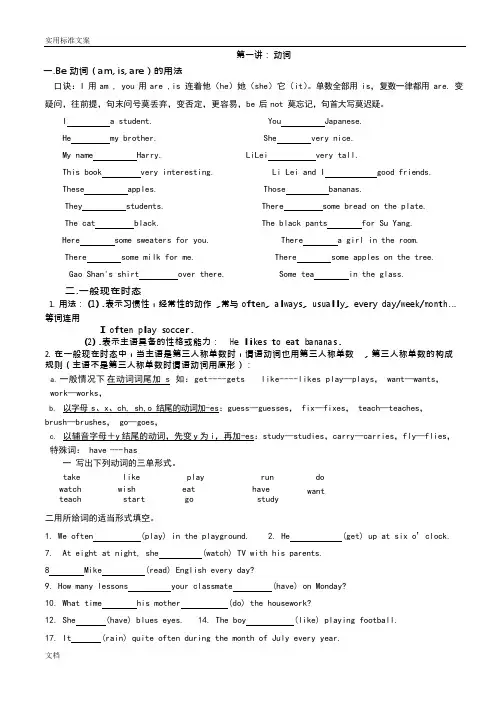
第一讲:动词一.Be 动词(am, is, are)的用法口诀:I 用 am , you 用 are ,is 连着他(he)她(she)它(it)。
单数全部用 is,复数一律都用 are. 变疑问,往前提,句末问号莫丢弃,变否定,更容易,be 后 not 莫忘记,句首大写莫迟疑。
I a student. You Japanese.He my brother. She very nice.My name Harry. LiLei very tall.This book very interesting. Li Lei and I good friends.These apples. Those bananas.They students. There some bread on the plate.The cat black. The black pants for Su Yang.Here some sweaters for you. There a girl in the room.There some milk for me. There some apples on the tree.Gao Shan's shirt over there. Some tea in the glass.二.一般现在时态1.用法:(1).表示习惯性,经常性的动作,常与o f t e n,a l w a y s,u s u a ll y,e v e r y d a y/w ee k/m o n t h…等词连用I o f t e n p l a y s o cc e r.(2).表示主语具备的性格或能力:H e li k e s t o e a t b a n a n a s.2.在一般现在时态中,当主语是第三人称单数时,谓语动词也用第三人称单数, 第三人称单数的构成规则(主语不是第三人称单数时谓语动词用原形):a.一般情况下在动词词尾加 s 如:get----gets like----likes play—plays, want—wants,work—works,b.以字母 s、x、ch, sh,o 结尾的动词加-es:guess—guesses, fix—fixes, teach—teaches,brush—brushes, go—goes,c.以辅音字母+y 结尾的动词,先变y 为i,再加-es:study—studies,carry—carries,fly—flies,特殊词: have --- has一写出下列动词的三单形式。
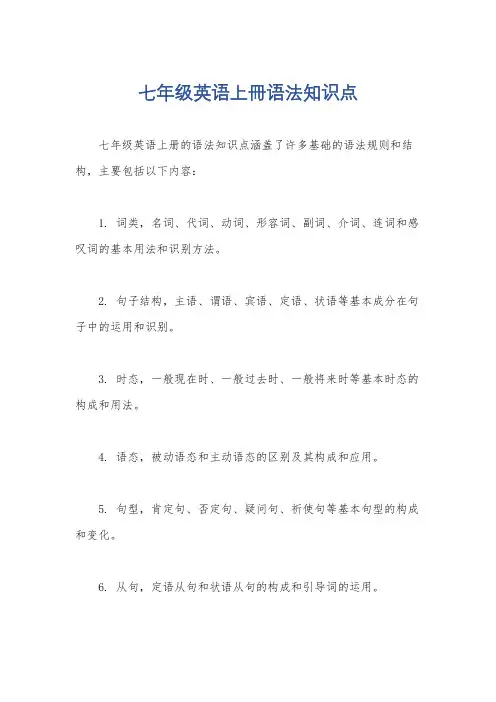
七年级英语上冊语法知识点
七年级英语上册的语法知识点涵盖了许多基础的语法规则和结构,主要包括以下内容:
1. 词类,名词、代词、动词、形容词、副词、介词、连词和感叹词的基本用法和识别方法。
2. 句子结构,主语、谓语、宾语、定语、状语等基本成分在句子中的运用和识别。
3. 时态,一般现在时、一般过去时、一般将来时等基本时态的构成和用法。
4. 语态,被动语态和主动语态的区别及其构成和应用。
5. 句型,肯定句、否定句、疑问句、祈使句等基本句型的构成和变化。
6. 从句,定语从句和状语从句的构成和引导词的运用。
7. 比较级和最高级,形容词和副词的比较级和最高级的构成和用法。
8. 数词,基数词和序数词的用法及其在句子中的位置。
以上是七年级英语上册的一些基础语法知识点,学生需要掌握这些知识点以建立起对英语语法的基本理解和运用能力。
通过练习和应用,学生可以逐渐提高对这些知识点的掌握程度,并在日常的英语学习和交流中更加准确地运用这些语法知识。
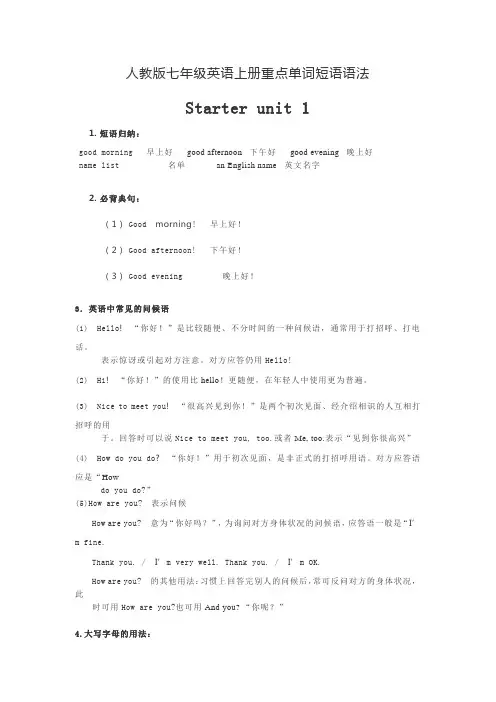
人教版七年级英语上册重点单词短语语法Starter unit 11. 短语归纳:good morning 早上好good afternoon 下午好good evening 晚上好name list 名单an English name 英文名字2. 必背典句:(1)Good morning! 早上好!(2)Good afternoon! 下午好!(3)Good evening 晚上好!3.英语中常见的问候语(1) Hello!“你好!”是比较随便、不分时间的一种问候语,通常用于打招呼、打电话。
表示惊讶或引起对方注意。
对方应答仍用Hello!(2) Hi!“你好!”的使用比hello!更随便,在年轻人中使用更为普遍。
(3) Nice to meet you!“很高兴见到你!”是两个初次见面、经介绍相识的人互相打招呼的用于。
回答时可以说Nice to meet you, too.或者Me, too.表示“见到你很高兴”(4) How do you do?“你好!”用于初次见面,是非正式的打招呼用语。
对方应答语应是“Howdo you do?”(5)How are you? 表示问候How are you? 意为“你好吗?”,为询问对方身体状况的问候语,应答语一般是“I’m fine.Thank you. / I’m very well. Thank you. / I’m OK.How are you? 的其他用法:习惯上回答完别人的问候后,常可反问对方的身体状况,此时可用How are you?也可用And you? “你呢?”4.大写字母的用法:(1) 在英语中,句子的第一个单词的第一个字母都应大写。
Sit down, please. 请坐。
(2)字母I作人称代词时,意为“我”,在句中任何位置都必须大写。
日常用语“OK”在句中任何位置都大写。
I’m a student. 我是一名学生。
Is everything OK? 一切都好吗?(3)人名、地名、国名、某国人或某种语言等专有名词的第一个字母都必须大写。
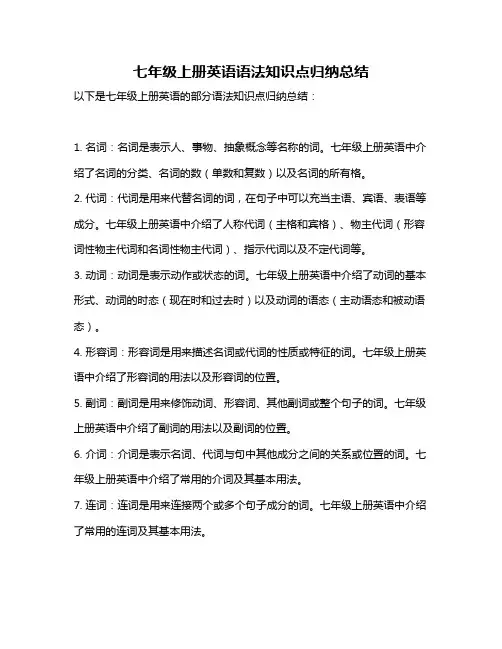
七年级上册英语语法知识点归纳总结
以下是七年级上册英语的部分语法知识点归纳总结:
1. 名词:名词是表示人、事物、抽象概念等名称的词。
七年级上册英语中介绍了名词的分类、名词的数(单数和复数)以及名词的所有格。
2. 代词:代词是用来代替名词的词,在句子中可以充当主语、宾语、表语等成分。
七年级上册英语中介绍了人称代词(主格和宾格)、物主代词(形容词性物主代词和名词性物主代词)、指示代词以及不定代词等。
3. 动词:动词是表示动作或状态的词。
七年级上册英语中介绍了动词的基本形式、动词的时态(现在时和过去时)以及动词的语态(主动语态和被动语态)。
4. 形容词:形容词是用来描述名词或代词的性质或特征的词。
七年级上册英语中介绍了形容词的用法以及形容词的位置。
5. 副词:副词是用来修饰动词、形容词、其他副词或整个句子的词。
七年级上册英语中介绍了副词的用法以及副词的位置。
6. 介词:介词是表示名词、代词与句中其他成分之间的关系或位置的词。
七年级上册英语中介绍了常用的介词及其基本用法。
7. 连词:连词是用来连接两个或多个句子成分的词。
七年级上册英语中介绍了常用的连词及其基本用法。
希望以上内容对你有帮助,建议查阅七年级上册英语教材或教辅,获取更详细和准确的信息。
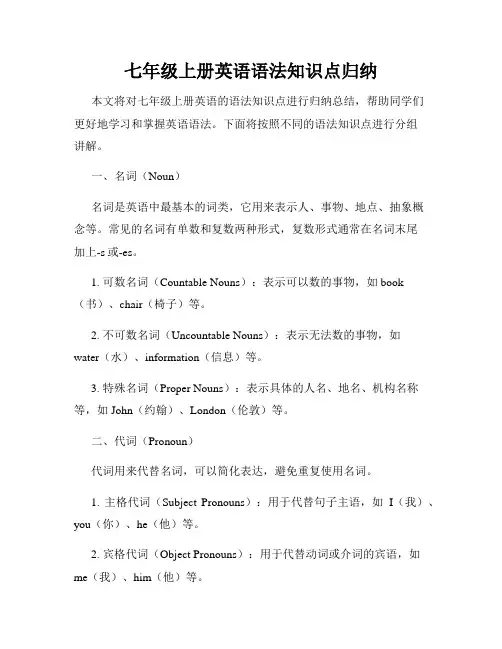
七年级上册英语语法知识点归纳本文将对七年级上册英语的语法知识点进行归纳总结,帮助同学们更好地学习和掌握英语语法。
下面将按照不同的语法知识点进行分组讲解。
一、名词(Noun)名词是英语中最基本的词类,它用来表示人、事物、地点、抽象概念等。
常见的名词有单数和复数两种形式,复数形式通常在名词末尾加上-s或-es。
1. 可数名词(Countable Nouns):表示可以数的事物,如book (书)、chair(椅子)等。
2. 不可数名词(Uncountable Nouns):表示无法数的事物,如water(水)、information(信息)等。
3. 特殊名词(Proper Nouns):表示具体的人名、地名、机构名称等,如John(约翰)、London(伦敦)等。
二、代词(Pronoun)代词用来代替名词,可以简化表达,避免重复使用名词。
1. 主格代词(Subject Pronouns):用于代替句子主语,如I(我)、you(你)、he(他)等。
2. 宾格代词(Object Pronouns):用于代替动词或介词的宾语,如me(我)、him(他)等。
3. 物主代词(Possessive Pronouns):表示所属关系,如mine(我的)、yours(你的)等。
三、动词(Verb)动词是句子中最重要的成分之一,表示行为、状态、存在等。
1. 动词的时态(Verb Tenses):包括一般现在时、一般过去时、一般将来时等。
2. 动词的进行时(Present Continuous):表示正在进行的动作或状态。
3. 动词的完成时(Present Perfect):表示过去发生的动作对现在的影响。
四、形容词(Adjective)形容词用来修饰名词,描述名词的特征和性质。
1. 形容词的比较级和最高级(Comparative and Superlative Adjectives):用来对比两个或多个事物的特征。
2. 形容词的位置(Position of Adjectives):通常形容词紧跟在名词之前。
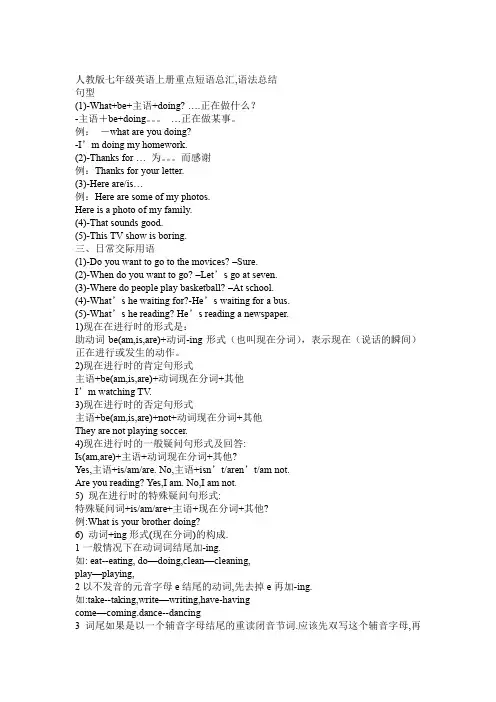
人教版七年级英语上册重点短语总汇,语法总结句型(1)-What+be+主语+doing? ….正在做什么?-主语+be+doing。
…正在做某事。
例:-what are you doing?-I’m doing my homework.(2)-Thanks for … 为。
而感谢例:Thanks for your letter.(3)-Here are/is…例:Here are some of my photos.Here is a photo of my family.(4)-That sounds good.(5)-This TV show is boring.三、日常交际用语(1)-Do you want to go to the movices? –Sure.(2)-When do you want to go? –Let’s go at seven.(3)-Where do people play basketball? –At school.(4)-What’s he waiting for?-He’s waiting for a bus.(5)-What’s he reading? He’s reading a newspaper.1)现在在进行时的形式是:助动词be(am,is,are)+动词-ing形式(也叫现在分词),表示现在(说话的瞬间)正在进行或发生的动作。
2)现在进行时的肯定句形式主语+be(am,is,are)+动词现在分词+其他I’m watching TV.3)现在进行时的否定句形式主语+be(am,is,are)+not+动词现在分词+其他They are not playing soccer.4)现在进行时的一般疑问句形式及回答:Is(am,are)+主语+动词现在分词+其他?Yes,主语+is/am/are. No,主语+isn’t/aren’t/am not.Are you reading? Yes,I am. No,I am not.5) 现在进行时的特殊疑问句形式:特殊疑问词+is/am/are+主语+现在分词+其他?例:What is your brother doing?6) 动词+ing形式(现在分词)的构成.1一般情况下在动词词结尾加-ing.如: eat--eating, do—doing,clean—cleaning,play—playing,2以不发音的元音字母e结尾的动词,先去掉e再加-ing.如:take--taking,write—writing,have-havingcome—coming.dance--dancing3词尾如果是以一个辅音字母结尾的重读闭音节词.应该先双写这个辅音字母,再加-ing.如:run—runing,sit—sitting ,swim—swimming.Shop—shopping.put—putting,sit—sittingUnit 6 It’s raning!一、词组Around The World 世界各地On vacation 度假Take photos 拍照On the beach 在海边a group of people 一群人play beach volleyball 打沙滩排球be surprised 惊讶的be surprised at sth./sb.对某人或某人感到惊讶be relaxed 放松have a good time 玩得很痛快in different kind of weather 在不同的天气里Thank sb for(doing)sth由于(做)某事而感谢某人How’s it going? 近况如何Some…others…一些…另一些…Look like..看起来像。
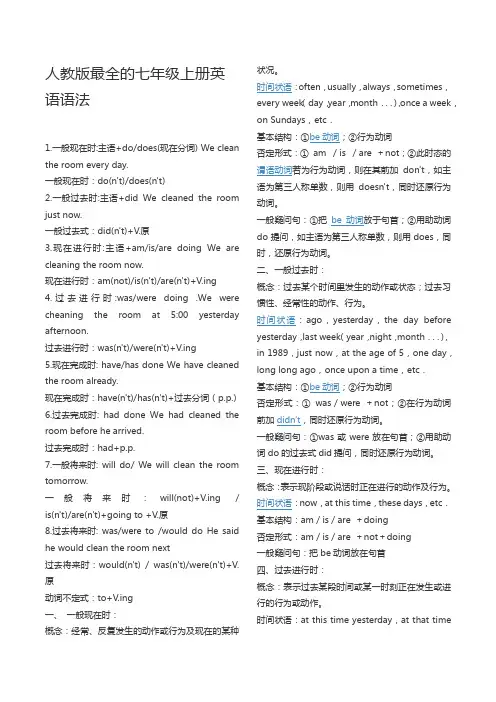
人教版最全的七年级上册英语语法1.一般现在时:主语+do/does(现在分词) We clean the room every day.一般现在时:do(n't)/does(n't)2.一般过去时:主语+did We cleaned the room just now.一般过去式:did(n't)+V.原3.现在进行时:主语+am/is/are doing We are cleaning the room now.现在进行时:am(not)/is(n't)/are(n't)+V.ing4.过去进行时:was/were doing .We were cheaning the room at 5:00 yesterday afternoon.过去进行时:was(n't)/were(n't)+V.ing5.现在完成时: have/has done We have cleaned the room already.现在完成时:have(n't)/has(n't)+过去分词(p.p.)6.过去完成时: had done We had cleaned the room before he arrived.过去完成时:had+p.p.7.一般将来时: will do/ We will clean the room tomorrow.一般将来时:will(not)+V.ing / is(n't)/are(n't)+going to +V.原8.过去将来时: was/were to /would do He said he would clean the room next过去将来时:would(n't) / was(n't)/were(n't)+V.原动词不定式:to+V.ing一、一般现在时:概念:经常、反复发生的动作或行为及现在的某种状况。
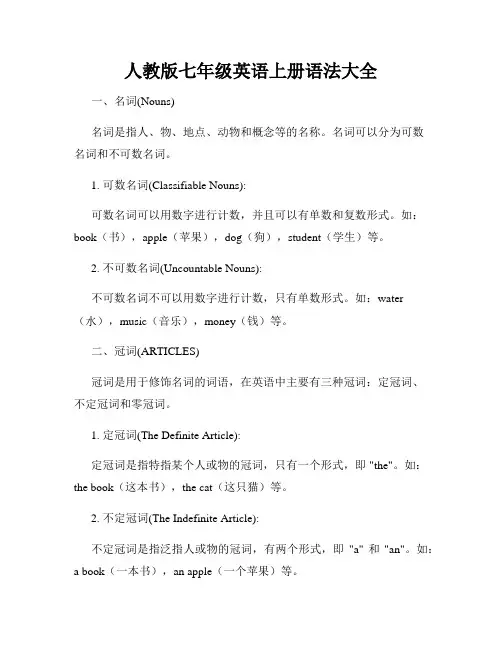
人教版七年级英语上册语法大全一、名词(Nouns)名词是指人、物、地点、动物和概念等的名称。
名词可以分为可数名词和不可数名词。
1. 可数名词(Classifiable Nouns):可数名词可以用数字进行计数,并且可以有单数和复数形式。
如:book(书),apple(苹果),dog(狗),student(学生)等。
2. 不可数名词(Uncountable Nouns):不可数名词不可以用数字进行计数,只有单数形式。
如:water (水),music(音乐),money(钱)等。
二、冠词(ARTICLES)冠词是用于修饰名词的词语,在英语中主要有三种冠词:定冠词、不定冠词和零冠词。
1. 定冠词(The Definite Article):定冠词是指特指某个人或物的冠词,只有一个形式,即 "the"。
如:the book(这本书),the cat(这只猫)等。
2. 不定冠词(The Indefinite Article):不定冠词是指泛指人或物的冠词,有两个形式,即"a" 和"an"。
如:a book(一本书),an apple(一个苹果)等。
3. 零冠词(Zero Article):零冠词是指名词前没有任何冠词修饰的情况,也可以表示泛指。
如:I like flowers(我喜欢花)。
三、形容词(Adjectives)形容词是用来描述或修饰名词的词语,通常位于名词前面。
形容词可以分为具体形容词和抽象形容词。
1. 具体形容词(Concrete Adjectives):具体形容词用来描述或修饰可以通过感官观察得到的名词。
如:red (红色的),big(大的),beautiful(美丽的)等。
2. 抽象形容词(Abstract Adjectives):抽象形容词用来描述或修饰无法通过感官观察得到的名词,表示情感、状态或性质等。
如:happy(快乐的),difficult(困难的),interesting(有趣的)等。
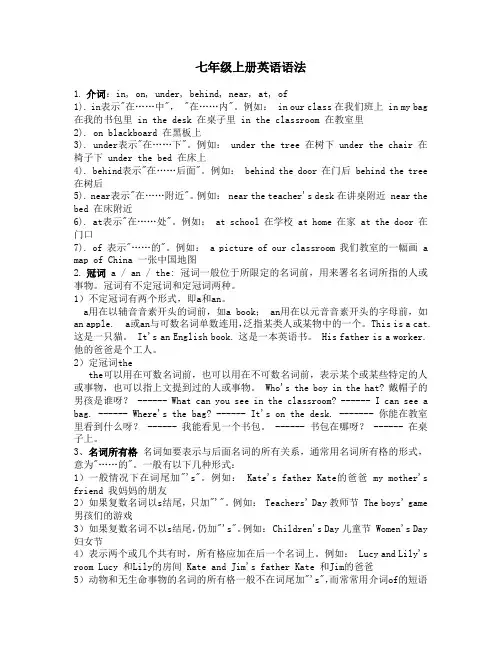
七年级上册英语语法1.介词:in, on, under, behind, near, at, of1). in表示"在……中", "在……内"。
例如: in our class 在我们班上 in my bag 在我的书包里 in the desk 在桌子里 in the classroom 在教室里2). on blackboard 在黑板上3). under表示"在……下"。
例如: under the tree 在树下 under the chair 在椅子下 under the bed 在床上4). behind表示"在……后面"。
例如: behind the door 在门后 behind the tree 在树后5). near表示"在……附近"。
例如: near the teacher's desk 在讲桌附近 near the bed 在床附近6). at表示"在……处"。
例如: at school 在学校 at home 在家 at the door 在门口7). of 表示"……的"。
例如: a picture of our classroom 我们教室的一幅画 a map of China 一张中国地图2.冠词 a / an / the: 冠词一般位于所限定的名词前,用来署名名词所指的人或事物。
冠词有不定冠词和定冠词两种。
1)不定冠词有两个形式,即a和an。
a用在以辅音音素开头的词前,如a book; an用在以元音音素开头的字母前,如an apple. a或an与可数名词单数连用,泛指某类人或某物中的一个。
This is a cat. 这是一只猫。
It's an English book. 这是一本英语书。
His father is a worker. 他的爸爸是个工人。
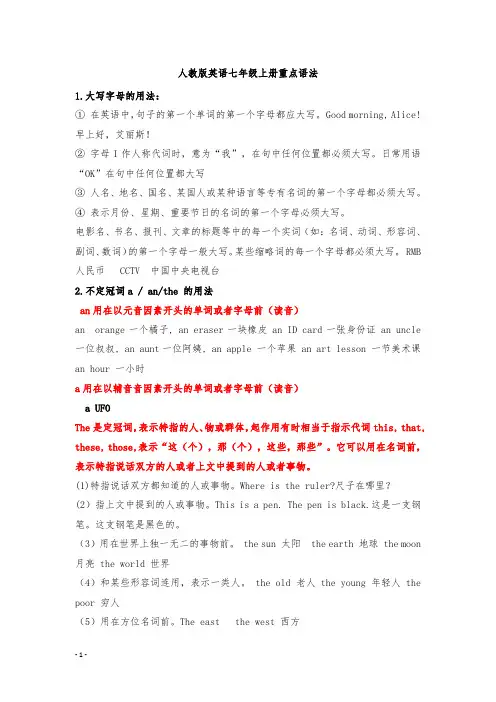
人教版英语七年级上册重点语法1.大写字母的用法:①在英语中,句子的第一个单词的第一个字母都应大写。
Good morning, Alice! 早上好,艾丽斯!②字母I作人称代词时,意为“我”,在句中任何位置都必须大写。
日常用语“OK”在句中任何位置都大写③人名、地名、国名、某国人或某种语言等专有名词的第一个字母都必须大写。
④表示月份、星期、重要节日的名词的第一个字母必须大写。
电影名、书名、报刊、文章的标题等中的每一个实词(如:名词、动词、形容词、副词、数词)的第一个字母一般大写。
某些缩略词的每一个字母都必须大写。
RMB 人民币 CCTV 中国中央电视台2.不定冠词a / an/the 的用法an用在以元音因素开头的单词或者字母前(读音)an orange一个橘子, an eraser一块橡皮 an ID card一张身份证 an uncle 一位叔叔, an aunt一位阿姨, an apple 一个苹果 an art lesson 一节美术课an hour 一小时a用在以辅音音因素开头的单词或者字母前(读音)a UFOThe是定冠词,表示特指的人、物或群体,起作用有时相当于指示代词this, that, these, those,表示“这(个),那(个),这些,那些”。
它可以用在名词前,表示特指说话双方的人或者上文中提到的人或者事物。
(1)特指说话双方都知道的人或事物。
Where is the ruler?尺子在哪里?(2)指上文中提到的人或事物。
This is a pen. The pen is black.这是一支钢笔。
这支钢笔是黑色的。
(3)用在世界上独一无二的事物前。
the sun 太阳 the earth 地球 the moon 月亮 the world 世界(4)和某些形容词连用,表示一类人。
the old 老人 the young 年轻人 the poor 穷人(5)用在方位名词前。
2024年英语七年级上册语法一、名词。
1. 可数名词与不可数名词。
- 可数名词有单复数形式。
例如:book(单数) - books(复数);apple - apples。
复数形式的构成规则如下:- 一般情况直接加 -s,如pen - pens。
- 以s,x,ch,sh结尾的名词加 -es,如box - boxes,watch - watches。
- 以辅音字母 + y结尾的名词,把y变为i再加 -es,如baby - babies。
- 以o结尾的名词,有生命的加 -es(如tomato - tomatoes,potato - potatoes),无生命的加 -s(如photo - photos)。
- 不可数名词没有复数形式,如water(水),milk(牛奶),rice(米饭)等。
表示数量时,要用“数词+量词+ of+不可数名词”,如a glass of water(一杯水),two bottles of milk(两瓶牛奶)。
2. 名词所有格。
- 有生命的名词所有格:- 一般在名词后加's,如Tom's book(汤姆的书)。
- 以s结尾的复数名词只加',如the students' classroom(学生们的教室)。
- 如果是两个人共有的东西,只在最后一个名词后加's,如Lucy and Lily's mother(露西和莉莉的妈妈);如果是各自拥有的东西,则在每个名词后加's,如Tom's and Jim's bikes(汤姆的自行车和吉姆的自行车)。
- 无生命的名词所有格常用“of+名词”结构,如the window of the room(房间的窗户)。
二、代词。
1. 人称代词。
- 主格:I(我),you(你/你们),he(他),she(她),it(它),we(我们),they(他们/她们/它们)。
主格在句中作主语,如I like English.(我喜欢英语。
七年级上册英语语法 Document serial number【KK89K-LLS98YT-SS8CB-SSUT-SST108】七年级上册英语语法(grammar)解析Name:___________ class:_________Unit11、Wh-questions特殊疑问句特殊疑问句是用来对句子中某一部分提问的疑问句,常以疑问代词(what、who、whom、whose、which)或疑问副词(when、where、why、how)放在句首进行提问,回答时需根据实际情况,不能用yes或No。
(1)what“什么”(对“事物”提问;用来询问人时涉及人的职业、外貌、身份。
)例:What is this这是什么What is your father你爸爸是干什么的What is the weather like today今天的天气如何What do you think of this film你认为这部电影怎么样What would you like to eat today你今天想吃什么(2)who“谁”(对“人”提问。
)例:Who is at the door谁在门旁Who is your English teacher谁是你的英语老师(3)which“哪个”(用来询问人或物,一般有特定的选择范围。
)例:Which city is bigger,Beijing or Shanghai哪个城市更大,北京还是上海Which one is taller,Li Liang or Li Leilei李亮和李雷雷,哪个高(4)whose“谁的”(对物主人提问。
)例:Whose bag is this这个包是谁的Whose father works in Shenzhen 谁的父亲在深圳工作(5)whom“谁”(前面有介词时只能用whom)例:With whom has he been to Beijing他和谁一起去北京的(6)when“什么时候”(对时间提问。
英语语法基础知识大全七年级上册一、名词(Nouns)名词是一个表示人、事物、地点或抽象概念的词。
可以分为专有名词和普通名词。
1. 专有名词专有名词是指具体的人、地点、团体或事物的名称。
例:Mary, London, United Nations2. 普通名词普通名词是指泛指一类人、事物或概念的名称。
例:school, cat, happiness二、动词(Verbs)动词是表示行为或状态的词。
三、形容词(Adjectives)形容词用来描述名词或代词。
四、副词(Adverbs)副词用来描述动词、形容词或其他副词。
五、介词(Prepositions)介词用来连接名词、代词或动词与其他词语。
六、冠词(Articles)冠词主要分为定冠词(the)和不定冠词(a/an)。
七、代词(Pronouns)代词用来代替名词,分为人称代词、指示代词、疑问代词、不定代词等。
八、连词(Conjunctions)连词用来连接词、短语或句子。
九、形容词比较级和最高级(Comparative and Superlative Adjectives)形容词的比较级和最高级用来比较不同事物的程度。
十、句子结构(Sentence Structure)英语句子结构主要包括主语、谓语、宾语、定语、状语等成分。
十一、词性和句子成分分析(Part of Speech and Sentence Analysis)了解词性和句子成分有助于正确理解句子的意思和结构。
以上是英语语法基础知识大全七年级上册的主要内容,希望对你有所帮助。
七年级上册英语语法一.Be 动词(am, is, are)的用法口诀:I 用am , you 用are ,is 跟着他(he)她(she)它(it)。
单数is,复数are. 变疑问,往前提,句末问号莫丢弃,变否定,更容易,be 后not莫忘记,疑问否定任你变,句首大写莫迟疑。
注意:be 动词通常会和其他词连写在一起,如:I’m , what’s ,name’s, they’re等。
I ________ a student.You ________ Janpanese.He _______ my brother.She_______ very nice.My name ________Harry.They _______ 10 years old.The books _________ new.Mary, this _________ Tom.There ________ a desk in the room.What_____ these二.冠词的用法冠词分为不定冠词(a ,an)、定冠词(the)和零冠词(不用冠词的情况)三种。
不定冠词a(an)与数词one 同源,是“一个”的意思。
a 用于辅音音素前,而an 则用于元音音素前。
定冠词the的用法:巧计定冠词the用法歌诀:特指双方熟悉,上文已经提起。
世上独一无二,方位名词乐器。
某些专有名词,还有复数姓氏。
序数词最高级,习惯用语要牢记。
零冠词的用法:1. 专有名词前一般不加冠词China 中国Europe 欧洲Lei Feng 雷锋William Shakespeare 威廉·莎士比亚2. 月份、星期、节日前一般不加冠词January 一月份Sunday 星期日Christmas Day 圣诞节Thanksgiving 感恩节National Day 国庆节May Day 劳动节注:民族节日前要加the 如:the Spring Festival3. 三餐、四季前一般不加冠词I have lunch at school.我在学校吃午餐。
七年级上册语法总结Numeral (num.表示名词、代词等和句中其他词的关系二、名词1.名词:表示人或事物的名称1)总的来说,名词分为专有名词和普通名词两类。
专有名词时个别的人、事物、地点等专有的名称,如:Gina, China等专有名词,专有名词第一个字母要大写。
2)名词按其所表示事物的性质分为可数名词和不可数名词。
可数名词(Countable Nouns)有复数形式,如:an apple, two apples。
不可数名词(Uncountable Nouns)一般没有复数形式,如:broccoli。
-es*本册出现的不可数名词有:broccoli*既可数又不可数名词有:ice cream,salad,chicken2. 名词所有格表示所属关系的一种格式1)-’s所有格清辅s de sk2) 无生命的名词的所有格,一般由“名词+of+名词”构成Eg:a map of China 一副中国地图the capital of America 美国的首都*双重所有格由“名词+of+-’s”或“名词+of+名词性物主代词”构成Eg:a friend of my mother’s 一个我妈妈的朋友a friend of theirs/his/hers/ours三、代词1. 含义:代词是代替名词以及起名词作用的短语、不定式、V-ing形式、从句或整个句子的词。
2. 代词的分类(本书涉及三类代词):1).指示代词2)人称代词3)物主代词表示所有关系的单词,是人称代词的属格形式。
物主代词又分为形容词性物主代词和名词性物主代词,本一、数词表示数目多少或顺序先后的词。
数词分为基数词和序数词。
2.序数词二、连词用来连接词与词、短语与短语或句子与句子的词,本册涉及的连词主要有两个and和but。
1. and “和”是并列连词,连接两个对等的成分eg:You and I are friends. 你和我是好朋友。
Lily and Lucy are sisters. 莉莉和露西是姐妹。
七年级上册英语语法1.介词:in, on, under, behind, near, at, of1). in表示"在……中", "在……内"。
例如: in our class 在我们班上 in my bag 在我的书包里 in the desk 在桌子里 in the classroom 在教室里2). on blackboard 在黑板上3). under表示"在……下"。
例如: under the tree 在树下 under the chair 在椅子下 under the bed 在床上4). behind表示"在……后面"。
例如: behind the door 在门后 behind the tree 在树后5). near表示"在……附近"。
例如: near the teacher's desk 在讲桌附近 near the bed 在床附近6). at表示"在……处"。
例如: at school 在学校 at home 在家 at the door 在门口7). of 表示"……的"。
例如: a picture of our classroom 我们教室的一幅画 a map of China 一张中国地图2.冠词 a / an / the: 冠词一般位于所限定的名词前,用来署名名词所指的人或事物。
冠词有不定冠词和定冠词两种。
1)不定冠词有两个形式,即a和an。
a用在以辅音音素开头的词前,如a book; an用在以元音音素开头的字母前,如an apple. a或an与可数名词单数连用,泛指某类人或某物中的一个。
This is a cat. 这是一只猫。
It's an English book. 这是一本英语书。
His father is a worker. 他的爸爸是个工人。
2)定冠词thethe可以用在可数名词前,也可以用在不可数名词前,表示某个或某些特定的人或事物,也可以指上文提到过的人或事物。
Who's the boy in the hat 戴帽子的男孩是谁呀 ------ What can you see in the classroom ------ I can see a bag. ------ Where's the bag ------ It's on the desk. ------- 你能在教室里看到什么呀 ------ 我能看见一个书包。
------ 书包在哪呀 ------ 在桌子上。
3、名词所有格名词如要表示与后面名词的所有关系,通常用名词所有格的形式,意为"……的"。
一般有以下几种形式:1)一般情况下在词尾加"'s"。
例如: Kate's father Kate的爸爸 my mother's friend 我妈妈的朋友2)如果复数名词以s结尾,只加"'"。
例如: Teachers' Day 教师节 The boys' game 男孩们的游戏3)如果复数名词不以s结尾,仍加"'s"。
例如: Children's Day 儿童节 Women's Day 妇女节4)表示两个或几个共有时,所有格应加在后一个名词上。
例如: Lucy and Lily's room Lucy 和Lily的房间 Kate and Jim's father Kate 和Jim的爸爸5)动物和无生命事物的名词的所有格一般不在词尾加"'s",而常常用介词of的短语来表示。
a map of China 一幅中国地图 the name of her cat 她的猫的名字 a picture of my family 我的家庭的一张照片 the door of the bedroom 卧室的门1)。
4、There be 的句子结构There be是一个"存在"句型,表示"有"的意思,肯定句的形式为:There be + 名词(单数或复数)+地点状语或时间状语。
1)be动词单复数的确定,看be后边第一个名词,当所接主语为单数或不可数名词时,be动词形式为is;当所接主语为复数名词时,be动词为are;当be动词后接两个以上主语时,be动词与最临近主语保持数上的一致。
意思为"某地有某人或某物"。
如:There is an eraser and two pens on the desk. 桌子上有一块橡皮和两支钢笔。
There are two pens and an eraser on the desk. 桌上有两支钢笔和一块橡皮。
2)there be的否定句,即在be的后面加上not。
否定形式为:There be + not + (any) + 名词+地点状语。
There is not any cat in the room. 房间里没猫。
There aren't any books on the desk. 桌子上没书。
3)there be句型的疑问句就是将be提到句首:Be there + (any) +名词+地点状语肯定回答:Yes, there is / are. 否定回答:No, there isn't / aren't. ---Is there a dog in the picture 画上有一只狗吗 ---Yes, there is. 有。
---Are there any boats in the river 河里有船吗 ---No, there aren't. 没有。
4)特殊疑问句:How many . . . are there (+地点状语)"某地有多少人或物"回答用There be . . . There's one. / There are two / three / some . . . 有时直接就用数字来回答。
One. / Two . . . ---How many students are there in the classroom 教室里有多少学生 ---There's only one. / There are nine. 只有一个。
/有九个。
5)如果名词是不可数名词,用:How much + 不可数名词 + is there + 地点状语 How much water is there in the cup 杯中有多少水 How much food is there in the bowl 碗里有多少食物一.动词be(is,am,are)的用法我(I)用am, 你(you)用are,is跟着他(he),她(she),它(it)。
单数名词用is,复数名词全用are。
变否定,更容易,be后not加上去。
变疑问,往前提,句末问号莫丢弃。
还有一条须注意,句首大写莫忘记。
5、this,that和it用法(1)this和that是指示代词,it是人称代词。
(2)距离说话人近的人或物用this, 距离说话人远的人或物用that。
如:This is a flower. 这是一朵花。
(近处)That is a tree. 那是一棵树。
(远处)(3)放在一起的两样东西,先说this, 后说that。
如:This is a pen. That is a pencil. 这是一支钢笔。
那是一支铅笔。
(4)向别人介绍某人时说This is…, 不说That is…。
如:This is Helen. Helen, this is Tom. 这是海伦,海伦,这是汤姆。
(5)This is 不能缩写, 而That is可以缩写。
如:This is a bike. That’s a car. 这是一辆自行车。
那是一辆轿车。
(6)打电话时,介绍自己用this, 询问对方用that。
如:—Hello! Is that Miss Green 喂,是格林小姐吗—Yes, this is. Who’s that 是的,我是,你是谁注意:虽然汉语中使用“我”和“你”,但英语中打电话时绝不可以说:I am…, Are you…/Who are you(7)在回答this或that作主语的疑问句时, 要用it代替this或that。
如:①—Is this a notebook 这是笔记本吗—Yes, it is. 是的,它是。
②—What’s that 那是什么—It’s a kite. 是只风筝。
6、these和those用法this, that, these和those是指示代词,these是this的复数形式,指时间,距离较近的或下面要提到的人或事;those是that的复数形式,指时间、距离较远或前面已经提到过的人或事物。
①This is my bed. That is Lily’s bed. 这是我的床。
那是莉莉的床。
②These pictures are good. 那些画很好。
③ Are those apple trees 那些是苹果树吗在回答主语是these或those的疑问句时,通常用they代替these或those以避免重复。
如:④Are these/those your apples 这些(那些)是你的苹果吗Yes, they are. 是的,他们是。
7、名词所有格1)单数名词后直接加“’s ”Jim’s coat 吉姆的外套 Jeff’s mother杰夫的妈妈2)以s结尾的复数名词,只加“’Teachers’ Day教师节 the twins’ books双胞胎的书3)不以s结尾的不规则的名词复数,加“’s ”Children’s Day 儿童节 men’s shoes男式鞋4)表示两者共同拥有时,只在最后一个名词后加’s5)表示两者各自拥有时,要在每个名词后加’sLucy and Lily’s mother 露茜和莉莉的妈妈(共同的妈妈,一个妈妈)Lucy’s and Kate’s rooms 露茜和凯特的房间(各自的房间,两间房子)8、一般现在时一般现在时表示经常性、习惯性的动作,或表示现在的特征、状态。
1)当主语是非第三人称单数时,行为动词的一般现在时变化形式(见下表)。
如:句式:主语+行为动词原形+其它例子:We speak Chinese.否定句:主语+don’t+行为动词原形+其他例子:We don’t speak Chinese.一般疑问句Do+主语+行为动词原形+其他例子: Do you speak Chinese肯定回答:Yes,主语+do 例子:Yes, we do.否定回答:No,主语+don’t 例子:No, we don’t.2)当主语是第三人称单数时,行为动词一般现在时的句型变化如下:(1)肯定句在行为动词原形后+s/es(其构成方法与名词单数变复数相同)。